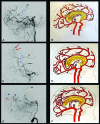Angiographic Analysis of Natural Anastomoses between the Posterior and Anterior Cerebral Arteries in Moyamoya Disease and Syndrome
- PMID: 31672836
- PMCID: PMC6975369
- DOI: 10.3174/ajnr.A6291
Angiographic Analysis of Natural Anastomoses between the Posterior and Anterior Cerebral Arteries in Moyamoya Disease and Syndrome
Abstract
Background and purpose: Moyamoya disease is a chronic neurovascular steno-occlusive disease of the internal carotid artery and its main branches, associated with the development of compensatory vascular collaterals. Literature is lacking about the precise description of these compensatory vascular systems. Usually, the posterior circulation is less affected, and its vascular flow could compensate the hypoperfusion of the ICA territories. The aim of this study was to describe these natural connections between the posterior cerebral artery and the anterior cerebral artery necessary to compensate the lack of perfusion of the anterior cerebral artery territories in the Moyamoya population.
Materials and methods: All patients treated for Moyamoya disease from 2004 to 2018 in 4 neurosurgical centers with available cerebral digital subtraction angiography were included. Forty patients (80 hemispheres) with the diagnosis of Moyamoya disease were evaluated. The presence of anastomoses between the posterior cerebral artery and the anterior cerebral artery was found in 31 hemispheres (38.7%).
Results: Among these 31 hemispheres presenting with posterior cerebral artery-anterior cerebral artery anastomoses, the most frequently encountered collaterals were branches from the posterior callosal artery (20%) and the posterior choroidal arteries (20%). Another possible connection found was pio-pial anastomosis between cortical branches of the posterior cerebral artery and the anterior cerebral artery (15%). We also proposed a 4-grade classification based on the competence of these anastomoses to supply retrogradely the territories of the anterior cerebral artery.
Conclusions: We found 3 different types of anastomoses between the anterior and posterior circulations, with different abilities to compensate the anterior circulation. Their development depends on the perfusion needs of the territories of the anterior cerebral artery and can provide the retrograde refilling of the anterior cerebral artery branches.
© 2019 by American Journal of Neuroradiology.
Figures



Comment in
-
Reply.AJNR Am J Neuroradiol. 2020 Jun;41(6):E42. doi: 10.3174/ajnr.A6503. Epub 2020 Apr 2. AJNR Am J Neuroradiol. 2020. PMID: 32241768 Free PMC article. No abstract available.
-
The Significance of Natural Anastomoses among Intracranial Vessels in Moyamoya Disease.AJNR Am J Neuroradiol. 2020 Jun;41(6):E41. doi: 10.3174/ajnr.A6502. Epub 2020 Apr 2. AJNR Am J Neuroradiol. 2020. PMID: 32241773 Free PMC article. No abstract available.
References
MeSH terms
LinkOut - more resources
Full Text Sources
Miscellaneous
